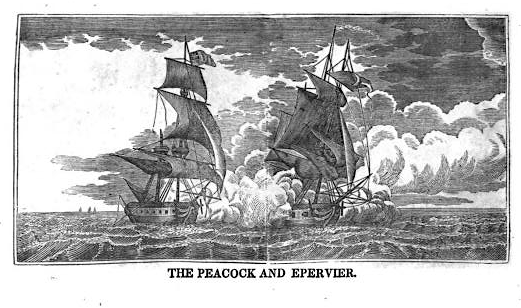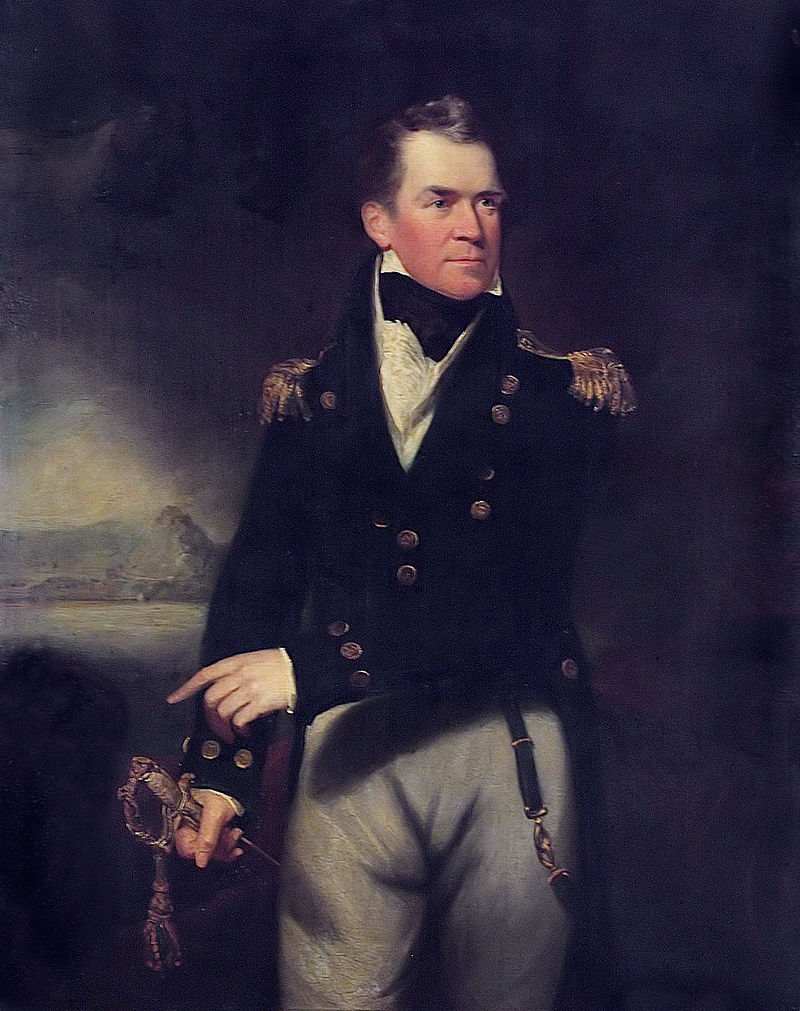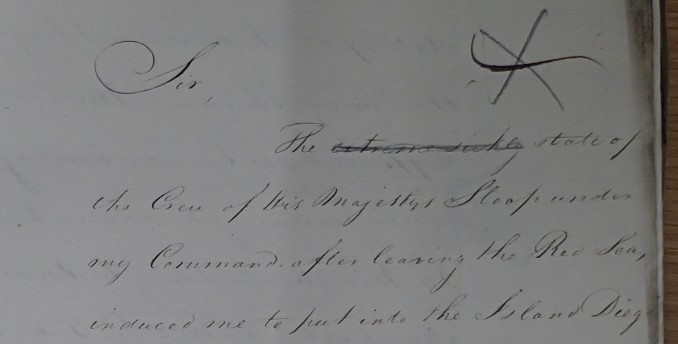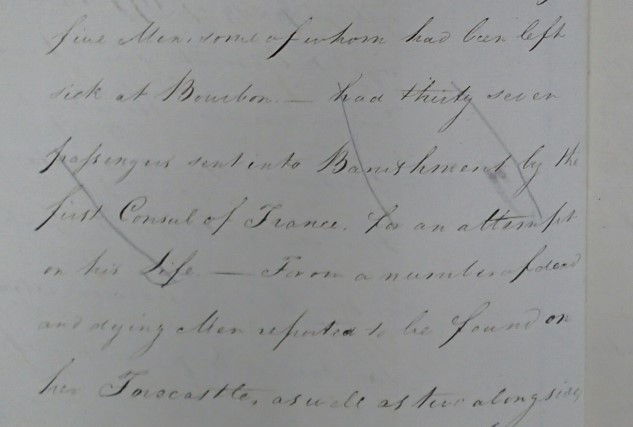
I’ve been rather enjoying getting to grips with the naval history of the Napoleonic (and pre-Napoleonic) era while researching Sir Home Popham. One of the things I discovered today was the comparatively minor action off the island of Mahé, one of the Seychelles, between HMS Victor (an 18-gun sloop) and the French corvette La Flèche (20 guns) on 5 September 1801.
At the time Popham was in command of the British squadron in the Red Sea (he wasn’t actually in the Red Sea at the time, of course — being Popham — but that’s another story altogether). The Victor, under Commander George Ralph Collier, had been detached for the purposes of gathering information on enemy ships cruising in the area of the Seychelles. Popham had given Collier strict instructions ‘on no account to risk’ his vessel, ‘the object on which you are sent being solely to obtain Information’ (20 July 1801, TNA ADM 1/2323), but Collier clearly stretched his instructions to the limit.

The account below is drawn from Collier’s official dispatch to Sir Home Popham, his direct superior, dated 10 September 1801 (TNA ADM 1/2323).
‘The extreme sickly state of the Crew’, Collier wrote, forced him to put into the island of Diego Garcia for supplies and water. On 27 August he left Diego Garcia and sailed off to continue his fact-finding mission. As befits an information-gathering vessel, he was disguised (Collier did not say how, but presumably he was sailing under different colours).
On 2 September he approached the Seychelles, where, in Collier’s words, he ‘fell in with a French National Corvette, and after a few ineffectual manoeuvres on her part, from the superior sailing of the Victor when going large, I had the pleasure of bringing her to a close action at 3/4 past 5 pm.’
Unfortunately for Collier, this first encounter didn’t go brilliantly. Although the Victor managed to fire a couple of broadsides, the enemy ‘solely directed her Fire at our Masts and Sails’, as a result of which ‘I had the Mortification to find, both lower and Topsail Braces shot away on the Starboard side’ along with some other damage. As a result, the Victor, although the superior sailor, was swiftly outstripped by the French vessel, which tacked under Collier’s lee and legged it with all speed to windward.
‘Night fast approaching added to the Chagrin I felt,’ Collier wrote, but he gave chase. Despite his best efforts, he lost sight of his prey on 4 September; but he guessed she was probably making for one of the Seychelles, and was delighted to discover her sitting in the inner harbour at Mahé ‘with a Red Flag at the Fore (which as I since learn was in defiance)’.
With the wind against him and unaware of the navigation of the harbour, Collier spent the next day or so sounding his way and then warping in after the French ship, which must have been fun, as the corvette didn’t wait for her enemy to approach and delivered ‘a raking fire’. At a quarter to twelve on the morning of 5 September, however, Collier managed to begin firing broadsides. The Victor kept this up until 2:20 pm, when Collier ‘plainly perceived the Enemy was going down; in a few minutes her Cable was Cut, she cast round, and her Bow grounded on a Coral Reef.’
Collier now sent his First Lieutenant, Mr McLean, on board the sinking enemy with a party of officers and men, but they quickly discovered the ship was on fire. More men were thus sent over to extinguish it, but it was too late: ‘she fell on her Larboard Bilge into Deeper Water, and Sunk.’ (Everyone managed to get off first.)
The French had lost four killed, although Collier thought that number had been underrepresented. He was very proud of having only two wounded and none killed, although, as he pointed out, 30 of his crew, including the Master, had been struck down with ‘a lingering fever’.
This brings me to one of the curiosities of Collier’s account, at least as it was published in the Gazette — because there are a couple of interesting discrepancies between the version submitted to Popham (which was forwarded on to the Admiralty), and the version that was officially published.

The first is the fever afflicting the crew of the Victor. I presume the reason this was downgraded was because the Admiralty didn’t think it necessary for the public to know about it, perhaps because prevalent sickness aboard the fleet might bring up awkward questions, or perhaps because the Admiralty didn’t want the enemy to know this particular British ship was in a weakened state: I’m not sure, but two small elisions were made. Captain Collier’s phrase ‘the extreme sickly state of the Crew’ became simply ‘the state of the crew’: and the ‘men labouring under the severity of a lingering Fever’ simply became ‘a lingering fever’ (although at least the existence of the fever was not written out … presumably because it enhanced the bravery of Collier’s crew).
More interestingly, two whole paragraphs were removed from Collier’s text. The final paragraph detailed the repairs Collier hoped to make to his vessel before continuing his journey. The second, however, is curious. Collier wrote of his discovery that he had destroyed La Flèche, with a crew of 140 men, and ‘thirty-seven passengers sent into Banishment by the first Consul of France for an attempt on his Life’.

This line is left out of the Gazette. Why? Again I’m not sure, but perhaps the chronology is critical here. The action between Victor and La Flèche took place on 5 September 1801, before the Peace of Amiens: but the Gazette was not published until 20 July the following year, four months after peace had been concluded. A detail that might have been useful in wartime, therefore, may have been left out to avoid irritating the head of state of a nation that was no longer an enemy … at least for the time being.
This is speculation on my part, but I find it an interesting example of what was considered worthy of publication.
References
The National Archives ADM 1/2323
The Naval Chronicle, vol. 8 (London, 1802) pp. 72-73

That’s really interesting. Was it Popham who made the decision what to remove from the report? I’ve recently met Collier myself, as he seems to have been in overall command of the squadron under Bloye which evacuated Castro Urdiales in 1813.
It wasn’t Popham — probably Evan Nepean, the Secretary to the Admiralty, or someone in his department. The letter was either sent in duplicate or a copy was made at the Admiralty to pass on to the Gazette as there are two copies, only one of which is marked up. I wonder if anyone pointed out to Collier that Popham had told him not to do anything stupid, like, you know, trailing after a slightly larger French ship halfway across the Indian Ocean…
I’d say that Collier preferred to quietly forget about that…
Popham seemed to have forgotten about it too!